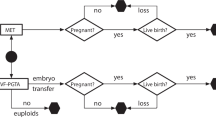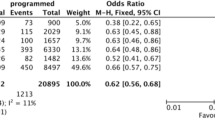Abstract
Purpose: This study was undertaken to evaluate simplified methods of human embryo coculture using either attached or nonattached autologous cumulus tissue.
Methods: Eight hundred one zygotes were cultured for 48 hr in a prospective, randomized trial comparing culture of embryos either with intact cumulus tissue, with cumulus tissue added to the droplet of culture medium, or without any cumulus tissue. In a follow-up study, embryo quality, pregnancy rates, and implantation rates were compared in 120 consecutive patients undergoing in vitro fertilization with a coculture system using cumulus tissue compared to a cohort of 127 patients undergoing IVF immediately preceding the institution of the coculture protocol.
Results: Embryo morphology was significantly improved (P < 0.05) following culture with attached cumulus tissue (5.61 ± 0.29) and culture with added cumulus tissue (4.72 ± 0.31) compared to that of embryos grown in culture medium without cumulus tissue (3.95 ± 0.26). The clinical pregnancy rate improved from 39.4% (50/127) to 49.2% (59/120) following institution of a system of coculture with attached cumulus tissue.
Conclusions: These data indicate that a simple coculture system using autologous cumulus tissue can result in improved embryo morphology, implantation rates, and clinical pregnancy rates during in vitro fertilization. This coculture system is simple, is non-labor intensive, and eliminates many of the risks which may be present in other embryo coculture systems.
Similar content being viewed by others
REFERENCES
Bongso A, Fong CY: The effect of co-culture on human zygote development. Curr Opin Obstet Gynecol 1993;5(5):585-593
Guerin J-F, Nicollet B: Interest of co-cultures for embryos obtained by in-vitro fertilization: A French collaborative study. Hum Reprod 1997;12(5):1043-1046
Lai YM, Chang MY, Chang FH, Lee CL, Lee JD, Chang SY, Huang HY, Wang ML, Chan PJ, Soong YK: The effects of Vero cell co-culture on human zygotes resulting from in vitro fertilization and oocytes following subzonal insemination. Chang Keng I Heush 1996;19(3):203-210
Menezo YJ, Sakkas D, Janny L: Co-culture of the early human embryo: Factors affecting human blastocyst formation in vitro. Microsc Res Tech 1995;32(1):50-56
Nieto FS, Watkins WB, Lopata A, Baker HWG, Edgar DH: The effects of co-culture with autologous cryopreserved endometrial cells on human in vitro fertilization and early embryo morphology: A randomized study. J Assist Reprod Genet 1996;13:386-389
Vlad M, Walker D, Kennedy RC: Nuclei number in human embryos co-cultured with human ampullary cells. Hum Reprod 1996;11(8):1678-1686
Wiemer KE, Cohen J, Wiker SR, Malter HE, Wright G, Godke RA: Co-culture of human zygotes on fetal bovine uterine fibroblasts: embryonic morphology and implantation. Fertil Steril 1989;52(3):503-508
Wiemer KE, Garrisi J, Steuerwald N, Alikani M, Reing AM, Ferrara TA, Noyes N, Cohen J, Beneficial aspects of co-culture with assisted hatching when applied to multiple-failure in-vitro fertilization patients. Hum Reprod 1996;11(11):2429-2433
Yeung WSB, Lau EYL, Chan AYF, Ho PC: The production of interleukin-1 alpha immunoreactivity by human oviductal cells in a co-culture system. J Assist Reprod Genet 1996;13:762-767.
Thibodeaux JK, Godke RA: Potential use of embryo co-culture with human in vitro fertilization procedures. J Assist Reprod Genet 1995;12:665-677
Ben-Chetrit A, Jurisicova A, Casper RF: Co-culture with ovarian cancer cell enhances human blastocyst formation in vitro. Fertil Steril 1996;65(3):664-666
Dirnfeld M, Goldman S, Gonen Y, Koifman M, Calderon I, Abramovici H: A simplified co-culture system with luteinized granulosa cells improves embryo quality and implantation rates: A controlled study. Fertil Steril 1997;67(1):120-122
Quinn P, Margalit R: Beneficial effects of co-culture with cumulus cells on blastocyst formation in a prospective trial with supernumerary human embryos. J Assist Reprod Genet 1995;13:9-14
Roudebush WE, Levine AS, Lodge JS, Tsai CC, Butler WJ: Human follicular fluid and mouse cumulus cells act synergistically to enhance preimplantation mouse Balb/cJ embryo development. J Assist Reprod Genet 1995;12:733-737
Fukaya T, Chida S, Murakami T, Yajima A: Is direct cell-to-cell contact needed to improve embryonic development in co-culture? Tohoku J Exp Med 1996;180(3):225-232
Abeydeera LR, Wang WH, Cantley TC, Rieke A, Day BN: Co-culture with follicular shell pieces can enhance the developmental competence of pig oocytes after in vitro fertilization: relevance to intracellular glutathione. Biol Reprod 1998;58:213-218
Desai NN, Goldfarb JM: Growth factor/cytokine secretion by a permanent human endometrial cell line with embryotrophic properties. J Assist Reprod Genet 1996;13(7):546-550
Lim JM, Hansel W: Improved development of in vitro-derived bovine embryos by use of a nitric oxide scavenger in a cumulusgranulosa cell co-culture system. Mol Reprod Dev 1998;50(1):45-53
Seifer DB, Freeman MR, Gardiner AC, Hill GA, Schneyer AL, Vanderhyden BC: Autologous granulosa cell co-culture demonstrates zygote suppression of granulosa cell steroidogenesis. Fertil Steril 1996;66(3):425-429
de Matos DH, Furnus CC, Moses DF: Glutathione synthesis during in vitro maturation of bovine oocytes: Role of cumulus cells. Biol Reprod 1997;57:1420-1425
Bongso A, Ng SC, Fong CY, Ratnam S: Co-cultures: A new lead in embryo quality improvement for assisted reproduction. Fertil Steril 1991;56(2):179-191
Leppens G, Sakkas D: Differential effect of epithelial cell-conditioned medium fractions on preimplantation mouse embryo development. Hum Reprod 1995;10(5):1178-1183
Lim JM, Hansel W: Roles of growth factors in the development of bovine embryos fertilized in vitro and cultures singly in a defined medium. Reprod Fertil Dev 1996;8(8):1199-1205
Liu LPS, Chan STH, Ho PC, Yeung WSB: Human oviductal cells produce high molecular weight factor(s) that improves the development of mouse embryo. Hum Reprod 1995;10(10):2781-2786
Author information
Authors and Affiliations
Rights and permissions
About this article
Cite this article
Carrell, D.T., Peterson, C.M., Jones, K.P. et al. A Simplified Coculture System Using Homologous, Attached Cumulus Tissue Results in Improved Human Embryo Morphology and Pregnancy Rates During In Vitro Fertilization. J Assist Reprod Genet 16, 344–349 (1999). https://doi.org/10.1023/A:1020533711711
Issue Date:
DOI: https://doi.org/10.1023/A:1020533711711




